SUMMARY
This is AI generated summarization, which may have errors. For context, always refer to the full article.

MANILA, Philippines – It has been a month since Israel launched Operation Protective Edge in Gaza, triggered by the abduction and killing of 3 Israeli teenagers in the West Bank.
Over weeks of fighting between the Israeli army and Palestinian militant group Hamas, nearly 2,000 people have been killed, according to the latest figures from the United Nations Office for the Coordination of Humanitarian Affairs.
The current crisis is the latest in a long history of conflict between the two sides. This year’s outbreak of violence is marked by continuous trade of rocket fire, attempts to broker truces, and the swift rise in casualties.
Both sides also used media as tools of propaganda, blaming the other side for racking up civilian deaths and drumming up support for actions which, each claimed, were done to protect their territories.
Here’s a look at what happened over a month of deadly fighting.
June 12 – Three Israeli teenagers are abducted in the West Bank: Gilad Shaer, Eyal Yifrah, and Naftali Fraenkel. The boys are students at a Jewish seminary, and went missing while hitchhiking between Bethlehem and Hebron.
Israeli Prime Minister Benjamin Netanyahu says he holds Palestinian president Mahmud Abbas accountable for the missing teenagers.

Following the disappearance, Israel launches a vast search and arrest operation. Thousands of Israeli soldiers sweep over the area, arresting about 80 Palestinian suspects. Many of them are senior members of militant group Hamas.
On June 14, the Israeli army says a rocket has been fired from Gaza into Israel. In response, Israel fires back with air strikes on southern Gaza, and claims it hit a “site of terrorist activity and a weapons depot.”
June 15 – As the search continues, Netanyahu openly blames Hamas, saying Israel knows “for a fact” that the militant group is behind the disappearance of the teenagers.
Netanyahu also holds the Palestinian Authority responsible, and says the kidnapping proves the “dangers of endorsing the Fatah-Hamas unity pact.”
June 20 – As Israeli troops continue house-to-house raids and a crackdown on Islamist militants, soldiers kill 15-year-old Mohammed Dudin in the West Bank. The military says it responded with live fire after rocks and firebombs were thrown at them.
About 330 people are detained, including 240 from Hamas. Five Palestinians are killed. Militants in the Gaza Strip continue firing rockets toward southern Israel; Israel respond with air strikes.
June 30 – Israel fings the bodies of the 3 teenagers near Hebron, in the southern West Bank, 17 days after they went missing. Bullet casings found at the scene suggest the 3 had been executed.
Netanyahu accuses Hamas of murder.
“They were kidnapped and murdered in cold blood by human animals,” he says. “Hamas is responsible and Hamas will pay.”
Hamas denies involvement in the killings. A senior Hamas official warns Israel reprisals would open “the gates of hell.”
At this point, more than 400 Palestinians have been arrested.
July 1 – Overnight, Israel launches a series of air strikes against 34 sites in the Gaza Strip.
The International Business Times reports that a Palestinian jihadi group had claimed responsibility for the Israeli teenagers’ murder.
Although Netanyahu maintains that Hamas is responsible, other reports suggest a “lone cell” loosely affiliated with the group – but not under direct orders from the leadership – may have been responsible.
The reports also suggests that Israel knew the boys were already dead when the manhunt began, using the raids as a cover to arrest Hamas members.
July 2 – A 16-year-old Palestinian teenager is abducted from his Shuafat neighborhood in occupied east Jerusalem. His body is found hours later in a forest in west Jerusalem.
Palestinians say Jewish extremists killed the teenager to avenge the murder of the Israeli teenagers.
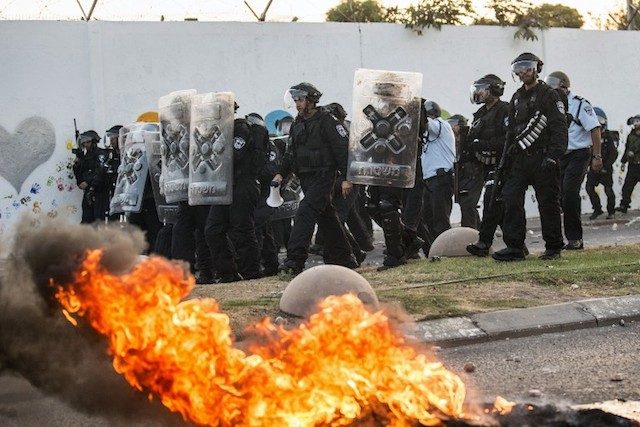
Clashes spread from east Jerusalem to Arab towns in central and northern Israel, following autopsy reports that show the Palestinian teenager was burned alive.
More rocket attacks are fired from Gaza, and Israeli warplanes attack 3 sites in southern Gaza.
July 8 – Israel begins Operation Protective Edge, launching dozens of air raids on the Gaza Strip overnight after rocket attacks from Hamas.
“Israel will not tolerate the firing of rockets on our cities and towns,” Netanyahu says, shortly after the security cabinet approved the call-up of some 40,000 reservists and orders the military to “toughen the response to Hamas.”
This starts the worst escalation in and around Gaza since November 2012.
July 9 – Israeli warplanes attack targets in the Gaza Strip, as Gaza militants fire missiles at Jerusalem and Tel Aviv, with some reaching as far away as Hadera.
Abbas accuses Israel of committing “genocide” in Gaza, with 43 Palestinians, including women and children, killed. More than 370 others are wounded.
Egypt urges an end to the spiraling conflict, but plays down a Cairo-mediated truce.
July 11 – As the deadly raids and rocket attacks continue, US President Barack Obama offers to broker a ceasefire to end hostilities, which have then pushed the death toll to 100.
Meanwhile, the UN human rights office says Israel can be violating laws of war by bombing Palestinian homes in Gaza. Israel accuses Hamas of deliberately firing from densely-populated Gaza to use civilians as human shields.
July 12 – As the death toll exceeds 150, both sides ignore calls for a truce and keep up the deadly attacks. Israel build up troops along the Gaza border, warning Palestinians to evacuate their homes ahead of a possible ground invasion.
Israel’s aerial campaign kill 157 Palestinians but hundreds of rockets from Hamas does not cause Israeli deaths, with many intercepted by the Iron Dome missile defense system.
The UN Security Council calls for a de-escalation of violence, urging both sides to respect “international humanitarian laws.”
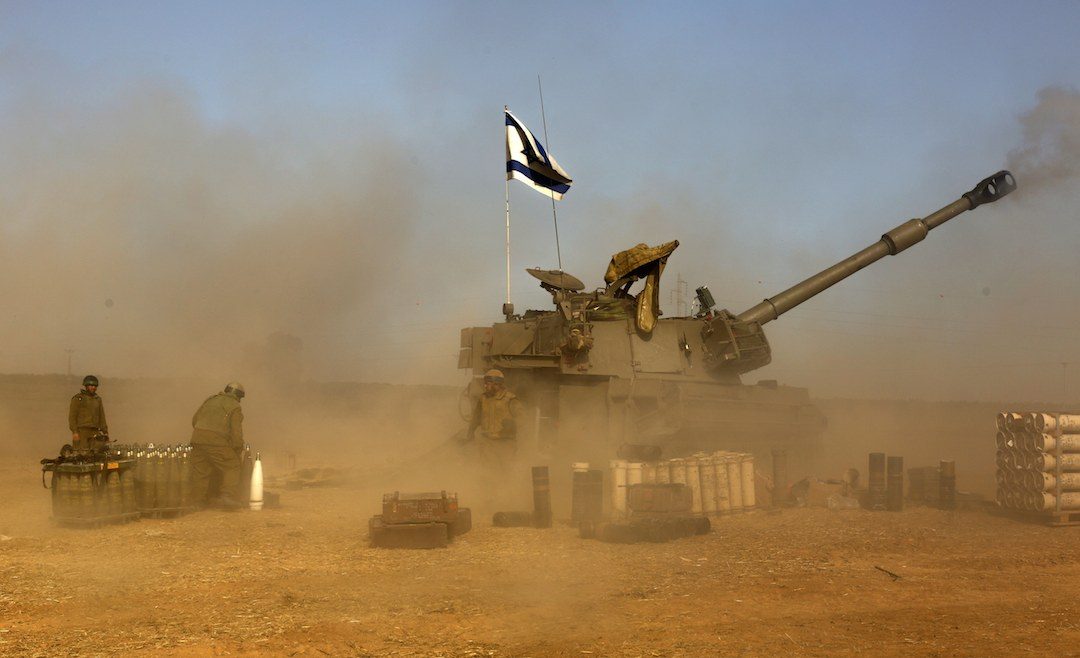
July 13 – Israeli navy commandos make the first ground incursion in the north of the Gaza Strip.
World powers prepare to meet to discuss an end to the bloodshed. Abbas says he will ask UN Secretary-General Ban Ki-moon to “put the State of Palestine under the UN international protection system.”
Despite calls for a ceasefire, Netanyahu warns there was no end in sight, saying Israel would not quit until it has achieved “sustainable quiet and security for our people.”
Defending Israel’s use of air strikes, Netanyahu blames Hamas for the civilian casualties in Gaza.
July 15 – Israel accepts a US-backed Egyptian truce plan as the death toll nears 200. But Hamas says they were not consulted on the proposal and rejects it, saying there would be no end to the attacks unless Israel agreed to its demands. The Israeli army holds its fire for 6 hours, but Hamas responds with scores of rockets over the border.
Responding to Hamas’ refusal of a ceasefire, Netanyahu says: “Hamas chose to continue fighting and will pay the price for that decision. When there is no cease-fire, our answer is fire.”
At this point, 186 Palestinians and one Israeli civilian have been killed. The death toll exceeds the number of casualties in the 2012 war.
July 17 – Israel and Hamas agree on a 5-hour humanitarian truce at the request of the UN. This comes a day after an Israeli strike kills 4 children on a beach in Gaza. The strikes continue, with Israeli military dropping flyers and sending text messages warning 100,000 people in northeastern Gaza to flee.
July 18 – Israel begins a ground invasion of Gaza, aiming to destroy a network of tunnels that ran under the border into Israel. Israel says Hamas used the tunnels to stage terror attacks in Israel.
Hamas says Israel will “pay a high price” for launching the ground offensive.
The death toll rises to 248. More than 80% of the victims were civilians, according to the Gaza-based Palestinian Centre for Human Rights.
Since the Israeli operation began on July 8, at least 1,150 rockets fired from Gaza struck Israel while 311 were shot down by the Iron Dome air defense system.
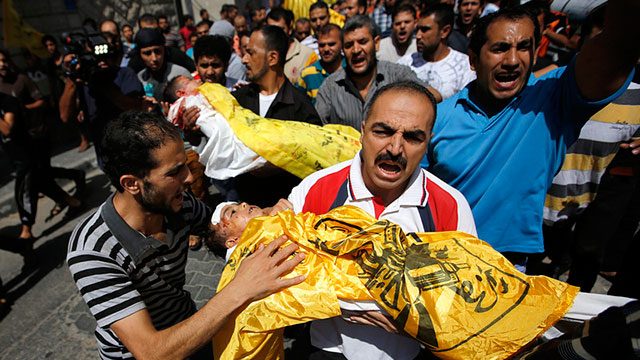
July 20 – It is the single bloodiest day in Gaza in 5 years: at least 100 Palestinians and 13 Israeli soldiers are killed in an hours-long assault on Shejaiya, near Gaza City. The death toll soar to 438.
Reporters describe the scene in Shejaiya as chaos and carnage: charred bodies on the streets, entire buildings collapsed and ablaze, dark smoke rising out of the rubble.
Diplomatic efforts to broker a truce gather pace, with Abbas arriving in Qatar to discuss a ceasefire with Hamas leader Khaled Meshaal, ahead of a visit by UN chief Ban Ki-Moon.
July 21 – The UN Security Council calls for an “immediate ceasefire” as the Palestinian death toll soars past 500, while on the Israeli side, 25 soldiers and two civilians have been killed.
July 22 –UN chief Ban Ki-moon and US Secretary of State John Kerry are in Cairo in a bid to broker a truce. World powers urge Hamas to accept an Egypt-brokered ceasefire and to stop firing rockets into Israel.
But Ban also calls on Israel to exercise “maximum restraint,” noting that while he understands Israel’s military response to protect its civilians, “there is a proportionality and…most of the death toll (has been) Palestinian people.”
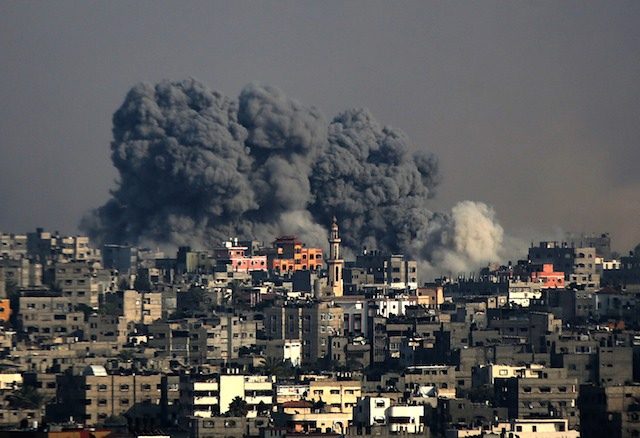
Meanwhile, major airlines cancell flights to and from Israel after a rocket fired from Gaza struck near the airport of Tel Aviv. Hamas calls the suspension of international flights a “great victory for the resistance” and “the crown of Israel’s failure.” (US airlines would lift the flight ban on July 24.)
July 24 – At least 15 people are killed in an explosion at a UN-run school in Beit Hanoun. The school houses some 100,000 Palestinian refugees.
Palestinians claim 3 Israeli tank shells hit the school, while the Israel Defense Forces says only a “single errant shell” crashed in the school’s courtyard. The IDF also claims to have aerial footage proving the shelter was empty when the shell exploded.
July 26 – Israel and Hamas begin a 12-hour humanitarian truce.
During the pause in conflict, at least 85 bodies are retrieved from the ruins of bombed-out buildings in Gaza.
US Secretary of State John Kerry and other top diplomats from Europe and the Middle East meet in Paris to press for a long-term ceasefire.
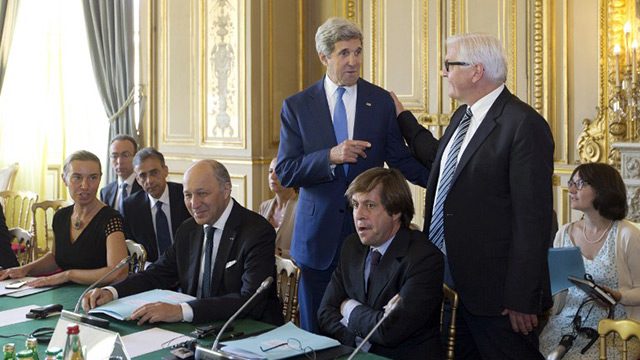
Following calls for a longer ceasefire, Israel agree on an extension, but Hamas resumes rocket fire, saying no ceasefire would be valid without the withdrawal of Israeli tanks from the Gaza Strip.
July 27 – Hamas asks for another truce, saying it is in response to a request from the UN. This comes after Israel said it would resume its military assault following Hamas’ rejection on Israel’s unilateral ceasefire.
Israel rejects the request, accusing Hamas of violating a ceasefire that it had itself called for and vowing to keep up Israeli operations in Gaza.
The fresh spate of violence prompts renewed calls for peace from world powers. Pope Francis calls on the two sides to stop the violence that has killed countless children.
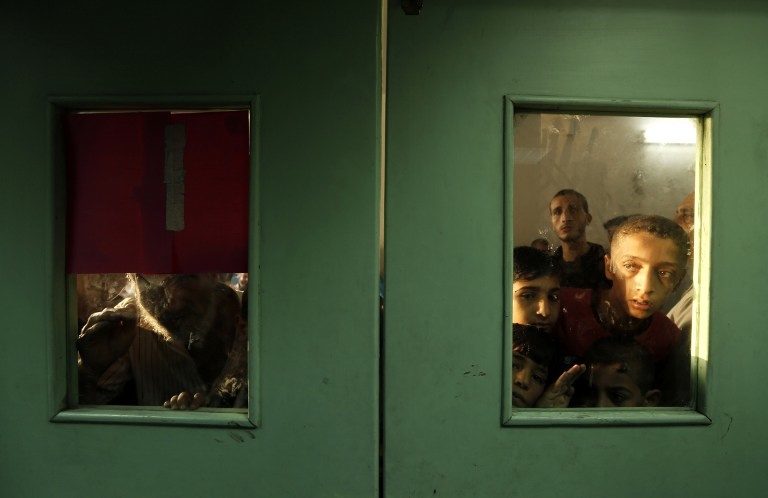
July 30 – A second UN-run school in Jabaliya refugee camp in northern Gaza is hit. Two Israel shells hit classrooms sheltering dozens of Palestinians, killing 16. The death toll rises over 1,260.
The UN refugee agency condemns what it calls a “serious violation of international law by Israeli forces.” More than 3,300 people have sought shelter at the school. UN figures showed up to 240,000 people have fled their homes due to the fighting.
Following outrage over the strike, Israel observes a four-hour lull in Gaza, but says it would not apply to areas where troops are “currently operating.” Hamas calls the move a publicity stunt, saying it had “no value.”
It is supposed to be a rare pause in hostilities, but hours into Israel’s 4-hour humanitarian lull, at least 17 people are killed in an Israeli air strike in a packed Gaza market.
Hamas later says it fired rockets at Tel Aviv and the southern port city of Ashkelon.
Israel mobilizes 16,000 more reservists, as Netanyahu says he would not accept a truce proposal that would not allow Israeli troops to continue destroying a network of cross-border tunnels.
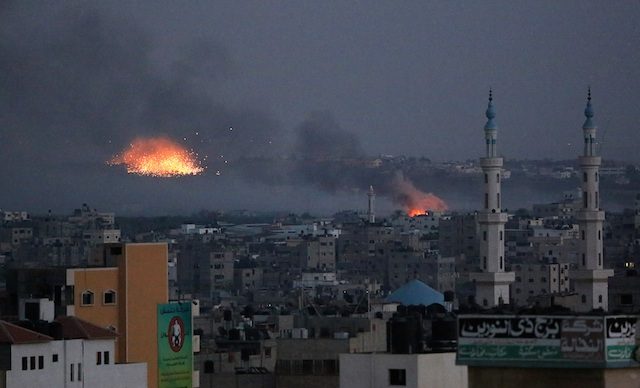
August 1 – Israel and Hamas agree on a 72-hour ceasefire. Egypt invites Israel and the Palestinian Authority to send delegates to Cairo for truce talks. The violence has killed 1,600 on the Palestinian side, and 63 Israeli soldiers and 3 civilians on the other.
Hours later, the truce collapses, with air raid sirens heard on the Israeli side and heavy shelling that kill dozens in the southern city of Rafah. Hamas accuses Israel of breaking the truce, but the Jewish state says it was responding to militant rocket fire.
Israel also says two soldiers were killed and a soldier, Hadar Goldin, was seized. Hamas confirms its militants had staged an ambush, but denies holding Goldin.
August 3 – Israel says Goldin had been killed in battle in the Gaza Strip, but says no body had been recovered. Both Israel and Hamas vow to continue their attacks, although Israel earlier pulled back troops from two areas in Gaza, in what was initially interpreted as a sign that Israel was winding down its operations.
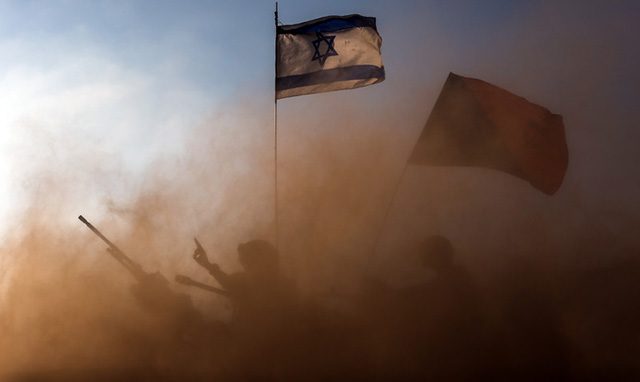
Netanyahu however promises Hamas would pay “an insufferable price” for continued cross-border rocket fire.
A senior Palestinian delegation lands in Cairo for talks on an Egyptian ceasefire plan, but Israel says it is not sending a negotiating team.
August 4 – Israel declares a unilateral truce amid outrage over a deadly strike on another UN school.
Ten people are killed in a strike on a school in the southern city of Rafah housing 3,000 Palestinians, the third such incident in 10 days.
Israel begins withdrawing some troops from Gaza with a military spokesman saying the ground operation was “changing gear.”
August 5 – After weeks of deadly fighting, Gaza falls silent as a 72-hour truce comes into effect.
The breakthrough comes during talks in Cairo, where Palestinian and Egyptian mediators hold two days of talks with Hamas and Islamic Jihad representatives.
Minutes before the ceasefire takes effect, Hamas fires 16 rockets over the border as Israeli warplanes begin launching 5 air strikes on Gaza.
Israel says it has withdrawn its troops from the Gaza Strip to “defensive positions” outside Palestinian territory, after a mission that sought to destroy 32 cross-border tunnels.
Figures from the UN Office for the Coordination of Humanitarian Affairs showed 1,814 Palestinians have been killed in the conflict. At least 1,312 of them were civilians, including 408 children and 214 women.
On the Israeli side, 67 were killed, including 64 soldiers. – Rappler.com
Add a comment
How does this make you feel?
There are no comments yet. Add your comment to start the conversation.